Care for Horses' Backs |
Chiropractic Care Day at the Ranch
|
|
Horses are athletes whose backs are constantly "horizontally loaded." Due to a number of factors, vertebrae and certain joints can become stuck or they can be forced out of their normal range of motion by muscle spasms (typically involving the shunt accessory muscles), as well as tendon or ligament injuries which alter the suspension of the joint. Typically these problems manifest themselves in the horse being unable to bend well in a particular direction, difficulty in talking a particular lead, reluctance to lift a foot to be picked or trimmed, Pain and/or flinching when saddled, uncharacteristic bucking or "freezing up", or a tail set which is not centered when the horse is going (except for Arabians who may naturally have an offset tail set). Suppling exercises can help prevent "stuck" joints. In cases of joints which have fallen out of their normal range of motion, scar tissue can develop in the joint capsules and more definitive correction may be required. The purpose of this information sheet is to provide some easy "do it yourself" ideas to keep your horse supple and free-moving. If you have an equine experiencing serious or recurrent back pain and/or some other apparent disability, consult with your veterinarian or a certified equine chiropractor to ascertain if exercise and movement will resolve your problem or if your animal needs more definitive professional care.
One of the things we want the horse to be able to do is roll his pelvis. This movement is akin to the coiling of the loins which is how the horse gets his hind feet under him in order to efficiently push forward (accelerate) and get in balance (collect himself). To accomplish this, the sacral joints must be free moving. We ask our mount to do "horsey sit-ups" to both test the flexibility of these joints and maintain their suppleness.
Once we have these points located, we will place our finger tips simultaneously over each point and scratch back and forth sideways. If we have located the right spot, the horse will "gather up" his loins and rotate them, lifting his back. Notice the topline and muscle tension in the horse below, comparing his back at rest on the left with the "situp" on the right. Although the difference is only a couple of inches, it takes a significant effort for the horse to lift himself this way. |
|
|
| ||
|
Please note: Know your horse before attempting this maneuver. You want to stimulate him to lift himself, but not irritate him and perhaps have him cow kick underneath himself (perhaps striking you). Getting overexuberant with belly stimulation can make some horses grouchy!
Using our index or forefinger, we press just hard enough to indent the skin, then "zip" our finger quickly sideways (using the edge of our fingernail like an ice skate blade), at an angle originating from the spine, over the rump to the flank. The angles run our approximately 30 to 45 degrees from the centerline of the spine. We'll make several passes going out both sides, each one at a slightly different angle. (From an aerial view it would look like we are drawing chevrons with our fingernails.) If the horse is experiencing nerve pressure, our fairly mild "zip" will cause a very visible ripple reflex in the muscle. Continue to Carrot Stretches Press Back to return to the page which brought you hereReturn to KBR Horse Health SectionReturn to KBR Training SectionGo to KBR Safety SectionReturn to KBR World of Wild Horses & BurrosGo To | |||

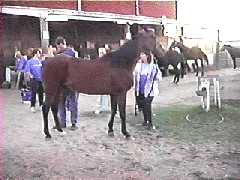
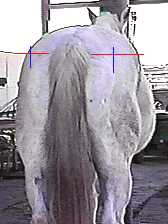 To get the horse to "sit-up", we first have to locate two points to
stimulate, illustrated in this picture. We visualize a horizontal
line (red) emanating near the top of the dock of the tail. This line will
intersect vertical lines (blue) which run inside the dimples, or poverty
lines, on either side of the tail where the muscles meet.
To get the horse to "sit-up", we first have to locate two points to
stimulate, illustrated in this picture. We visualize a horizontal
line (red) emanating near the top of the dock of the tail. This line will
intersect vertical lines (blue) which run inside the dimples, or poverty
lines, on either side of the tail where the muscles meet.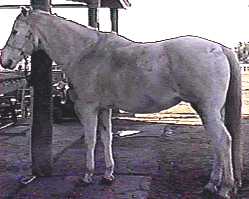

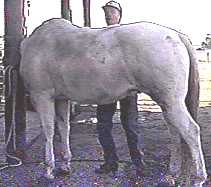
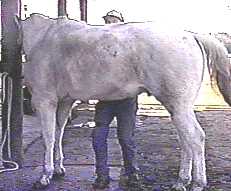
 We like to check for soreness in the lumbar area, particularly if we're
not sure of the saddle fit or think the horse might be stepping out short
in the hind end. This is an easy check we do with one finger tip.
We like to check for soreness in the lumbar area, particularly if we're
not sure of the saddle fit or think the horse might be stepping out short
in the hind end. This is an easy check we do with one finger tip.